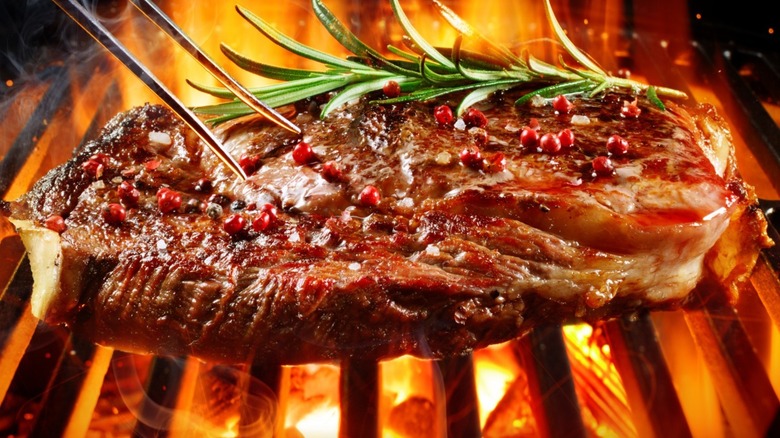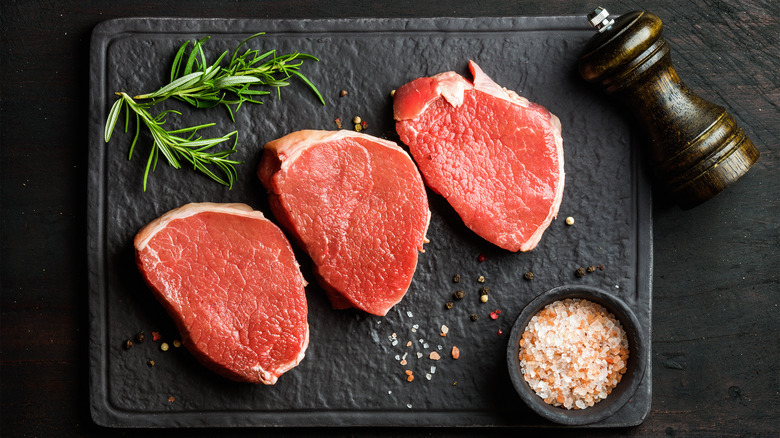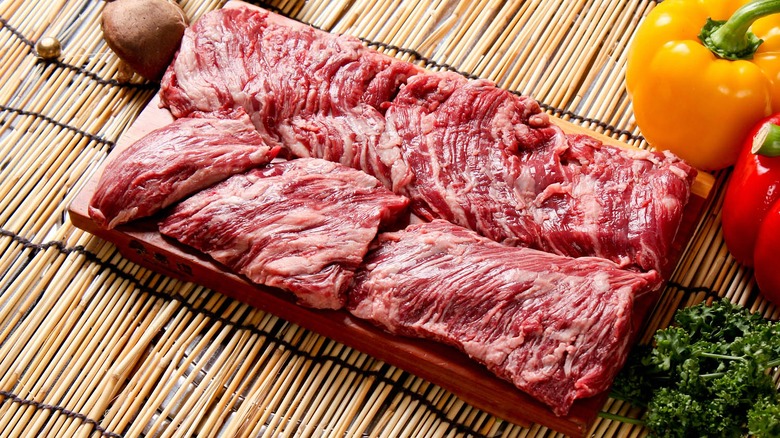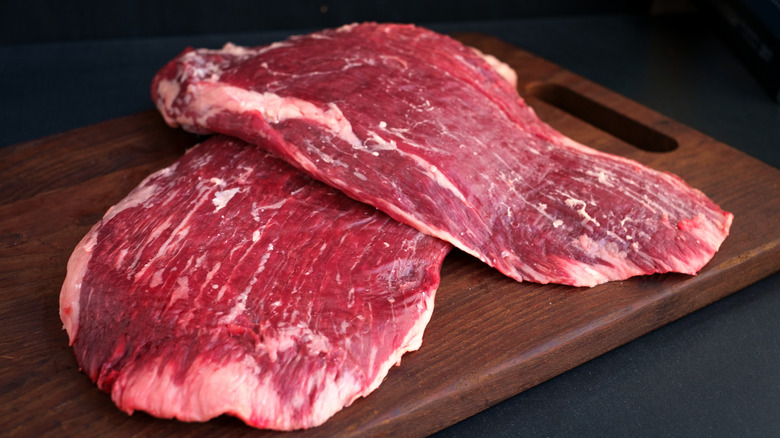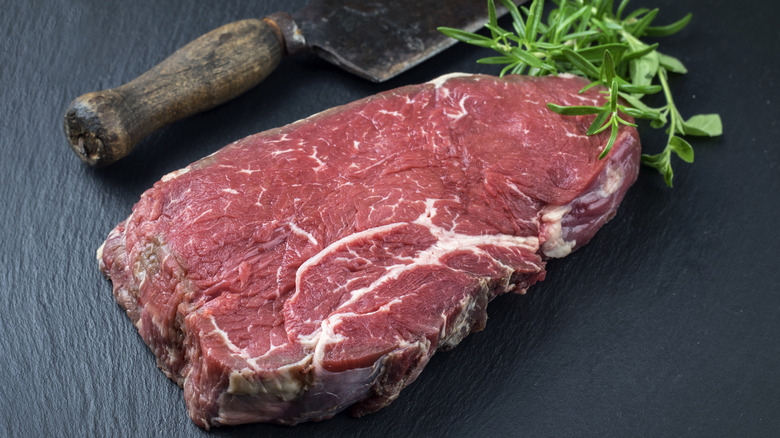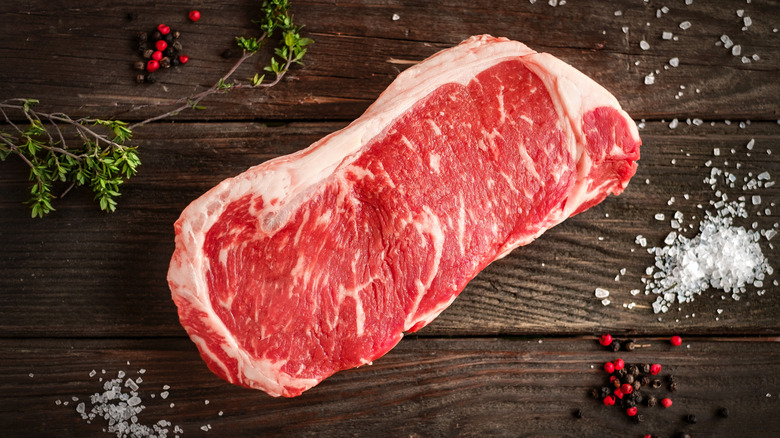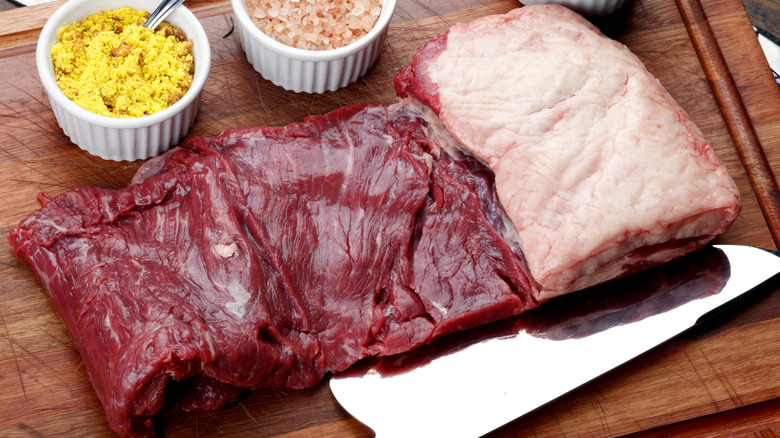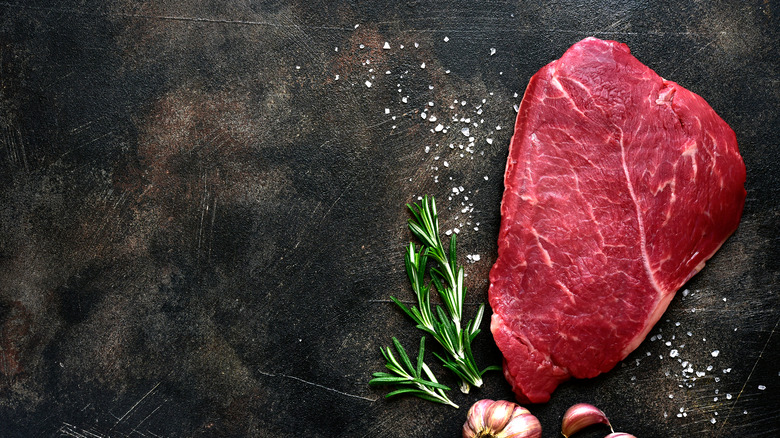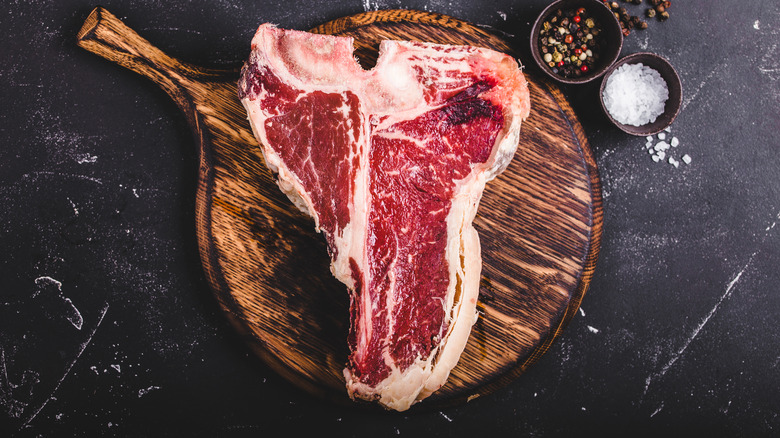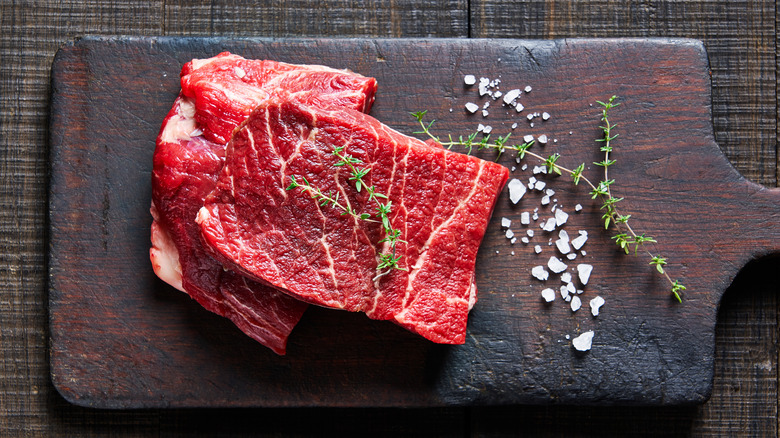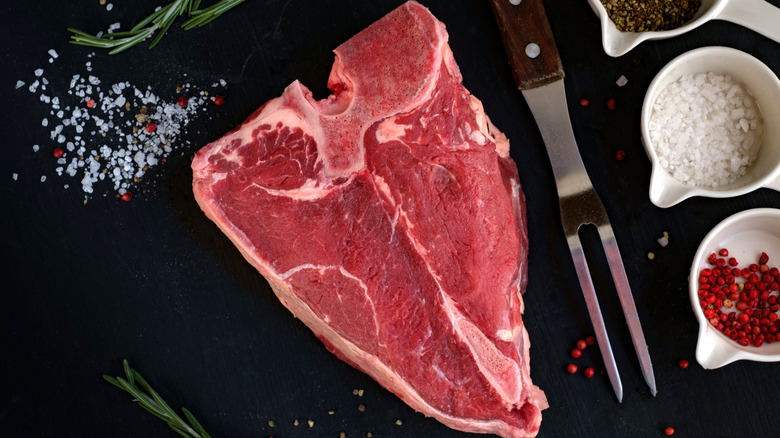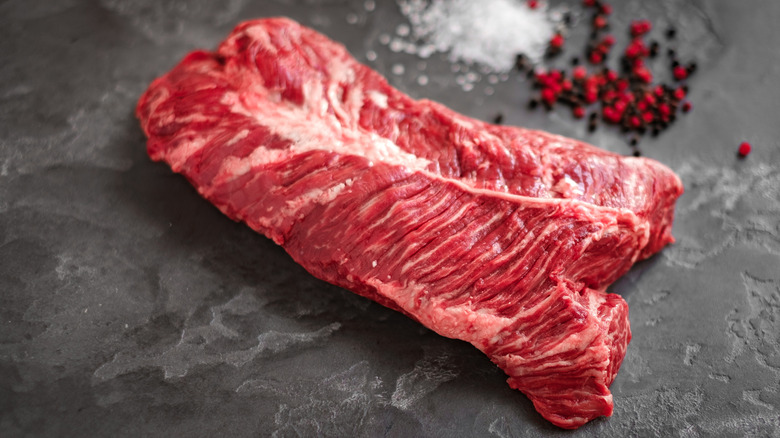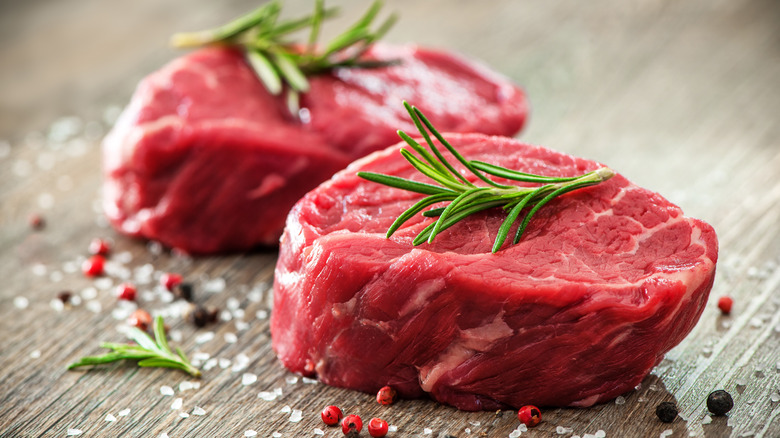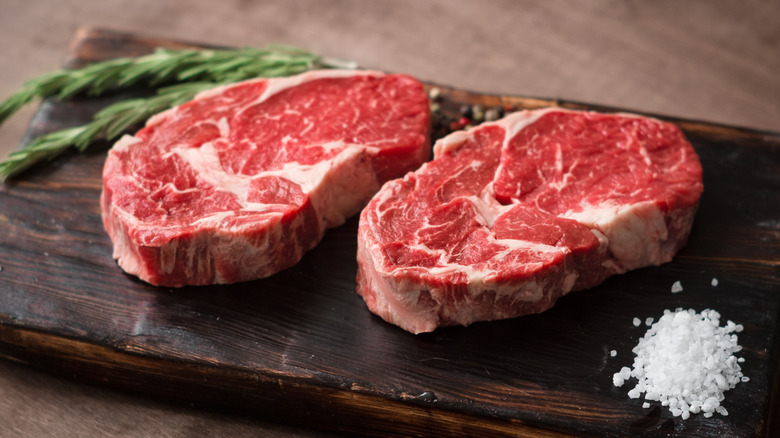Cuts Of Steak, Ranked Worst To Best
Pretty much everyone loves a good steak. After all — unless you're vegetarian or vegan — there's nothing quite like a nice cut of beef, grilled or fried nicely with a little bit of seasoning, and served with a nice batch of fries or potatoes. Sounds great, right? The problem is, however, that there is such a thing as a bad steak.
In fact, the rift in quality between a great steak and a bad steak is perhaps greater than any other food; just as the best can make your day, so too can the worst totally ruin it. And there are plenty of mistakes to make when cooking up a steak, of course: you might overcook or undercook it, you might cut into it too soon, or, of course, you might start things off with the wrong cut of beef. There are so many different cuts that can be cooked as steaks, and — let's just say — some are better than others. These are some of the most famous cuts of steak, ranked from the very worst to the very best.
13. Round steak
It's probably important to point out that few cuts of steak are genuinely nasty. Some are better than others, sure, but most have some kind of purpose and there aren't many that you ought to genuinely avoid at any cost.
Then again, there is the beef round. It's a large primal cut of the cow, mainly coming from its rear leg and rump. It's made up of three parts — the top, the tip, and the bottom. Let's start with the top round. It's basically the most tender part of the round, though that's not saying much, and tends to be extremely tough and lean. This cut of beef is fantastic for roast beef or a slow cooker pot roast recipe your family will beg for. As a steak, however, it's next to useless. It's way, way too tough, and is lean enough to make it basically devoid of flavor.
The tip isn't much better. Otherwise known as sirloin tip, this lean, boneless cut might do you a good kabob or stew, but the connective tissue in there means that, unless you braise it, it's going to turn out all chewy and gross.
Finally, there's the bottom round — which includes the eye of round, a cut of meat The Splendid Table once called "one of the few unredeemable cuts of meat." Nigh-on tasteless, tougher than John Wick and absolutely not worth your money, no matter how cheap it comes. Avoid.
12. Skirt steak
Skirt steak comes from the part of the cow known as the plate, which is essentially the muscle that you find inside the chest and below the ribs. Although you can get two different kinds of skirt, inside and outside, they're not that different from each other; and you're most likely to come across inside steak at the grocery store, since the outside is far more difficult to get hold of.
Skirt does have one or two things going for it. Mainly, the fact that it's genuinely quite flavorful — although, like the round, it's still best cut into thin slices than served as a full steak. This is because it's a very tough, muscle-heavy cut, meaning overcooking by just the slightest amount is going to make you very unhappy. If you really must cook skirt steak, keep it rare or medium rare at the very most.
Frustratingly, although they're fine to pan-fry, the long shape of the skirt makes it unwieldy to prepare and season, and a total nightmare to fit into all the but the largest pans. For many, skirt steak just isn't worth the fuss. That said, you may find that this simple 3-ingredient steak marinade is all you need to elevate the cut of meat.
11. Flank steak
Like skirt steak, the flank cut of beef comes from the underside of the cow — this time a little further back, right behind the plate. It's actually very similar to skirt steak too, with each having their own advantages and neither really being much better or worse than the other. The main difference is that, while skirt steak is a flavorful, tough steak, flank steak is a slightly less tough, yet also more flavorful cut of beef. That's not saying much, however, and flank steak does still tend to be tougher than many other cuts.
Again, you're generally not going to want to cook flank as a steak at all unless you intend to serve it as thin slices, but they do at least marinade nicely. As ever, remember to cut against the grain or you're in for a whole world of pain.
All things considered, there's not a lot more to be said for this one. We can't really tell you which to go for if you've got a choice between flank steak or skirt steak — it probably depends on whether you prize taste over tenderness, or vice versa; but there's really not a whole lot of difference between the two. Either way, you're probably better off with something else.
10. Bottom sirloin
The sirloin is one of the most famous cuts of beef, but it's actually generally divided up into three smaller cuts: the top sirloin, the bottom sirloin, and the rear part of the tenderloin. These different parts vary wildly in general quality, tenderness, and flavor. By and large, the bottom sirloin is the inferior cut of the three.
The sirloin is the hip of the cow, with the bottom sirloin being taken from the upper hip section. Now, the bottom sirloin is actually great for roasting, but it's generally not great for turning into steaks, unless — like the flank or skirt — you fancy slicing it up and marinating it. Even then, it's going to be a little too chewy, especially compared to the meat from the top sirloin. Equally, certain parts of the bottom sirloin, such as the tri-tip, ball-tip, or flap steak, will do well for dishes such as kebab or stew.
Use it purely for a steak, however, and the bottom sirloin is likely to prove tough, chewy, and chunky. Bottom line: it's probably not going to be the worst steak you'll ever eat, but it definitely won't be the best, either.
9. Strip steak
Otherwise known as the New York strip, the ambassador steak, the strip loin steak, the Kansas City strip, the club steak, the Omaha steak, or whatever other name you care to give it, the strip steak is a cut of meat that comes from the short loin, which is located in the top-center of the cow's body, just in front of the sirloin. Put more simply, the strip cut is what remains once you take the tenderloin away from the short loin. Serve them together, and you've got a T-bone or Porterhouse steak — which we'll come on to in good time.
Now, if you're after a middle ground between tender and tough, the strip steak is probably the steak for you. It's got a little chew to it, without being a nightmare to eat. It's also great for flavor and moisture, thanks to the marbling you'll find across the breadth of the cut. Sadly, however, this marbling does mean strip steak can be a little on the pricey side, and it's debatable whether that extra cost is really worth it, especially compared to some of the other (arguably superior) expensive cuts out there.
For the record, you can sometimes find bone-in strip steaks (think of it like a T-bone without the tenderloin) which are otherwise known as shell steaks or club steaks, and these versions pack some extra flavor. Always worth considering, but again, expect to pay a little more for the privilege.
8. Vacio or bavette steak
One of the steaks you might not have heard of is the vacio steak, an extremely popular steak in Argentina (but it's available here too). The vacio is a primal cut of the flank, but it's actually quite different from a flank steak. In the cow, the vacio hangs beneath the loin and is bolstered by the cow's belly, which encases the meat in layers of fat. It's always slow-grilled whole, then sliced, and the well-marbled meat is tender and very flavorful. The crispy belly fat is almost as cherished as the steak itself.
In France, the vacio steak is called the bavette d'aloyau. It's the exact same cut, but as you might expect, it's cooked in the French way. The bavette is cut into individual steaks and is either marinated and grilled or pan-fried in butter (naturally!) and served with a shallot sauce and French fries. So, the next time you're sipping wine in a bistro on the Champs-Élysées, and see steak-frites (steak and fries) on the menu, order it, and enjoy a steak that's loved on two continents.
7. Top sirloin
Now we come to the other part of the sirloin, and by far the better choice for steak fans. The top sirloin comes from — you guessed it — the upper portion of the sirloin butt, and is usually presented in the form of a tender, boneless steak. Now, while it may not be the most tender cut of beef, especially compared to some of the pricier cuts, it's not too tough at all and careful cooking can prevent it from becoming too chewy.
The great thing here is that top sirloin is hugely flavorful, and often marbled nicely. It's also fairly lean, making it a little healthier than its rival cuts. But the best thing top sirloin has going for it is that it's great value for money. You're unlikely to have to shell out as much cash as you would for a good ribeye or T-bone, for example, but you're going to get a much better steak than cheaper options such as the round or bottom sirloin. It's also versatile, being as suitable to a Stroganoff or a kebab as it is a steak. If you're cooking on a budget, this is probably one of the best options you could choose.
6. T-bone steak
A T-bone steak is cut from the short loin on a steer, and contains both a strip of top loin (i.e. a strip steak) and a nice big slab of tenderloin. And what you've got here is a great combination of the texture and flavor of those two cuts, in one impressively-sized chunk of beef. The strip steak has got all the flavor, and the tenderloin has got that amazing, tender feel to it. With the T-bone, you get to experience both at once. The last big positive of the T-bone, if you're the kind of person who gets a kick out of this (and who isn't?) is that T-bone steaks are always the ones you see in cartoons. And they always look so good.
There are two downsides to T-bone steaks, though. The first is that they're usually crazy expensive, partly because they combine two prized cuts of beef, and partly because they seem to have become so popular in high-end restaurants. The other is that they lack some of the versatility of tenderloin alone, which can be used in a number of different ways. They're not huge negatives, however, and if you're hankering for a good old fashioned hunk of steak — a real steak lover's steak, you know? — then you can probably do no better.
5. Flat iron steak
Also known as butler's steak or boneless top chuck steak, flat iron steak is a relatively modern cut of beef as far as butchering techniques go. According to Kansas City Steaks, flat iron steak comes from the shoulder region or "top blade" section of a cow. The meat is full of rich juicy marbling and is incredibly tender but for years had been considered unusable because of a very tough sinew that typically runs through that region of the animal.
Omaha Steaks has reported that researchers at the University of Nebraska and the University of Florida actually set out on a scientific study to figure out how to best make use of the piece of meat, ultimately determining that if you sliced the meat off at either side of that tough sinew, you'd be left with an intensely flavorful and highly affordable cut that was ideal for grilling, broiling, or pan-frying. And they were right!
Many chefs consider the flavor and texture of flat iron steaks similar to more popular and pricy cuts like filet mignon. By definition, they're inherently smaller pieces of meat so you may not want flat iron for a Sunday feast. But for an affordable, week-night dinner they're ideal whether you're eating them whole and fresh from the grill or cast-iron skillet or slicing thinly for a stir-fry or fajita. Because of the ample marbling, most experts recommend cooking flat iron steaks to medium-rare and seasoning liberally with coarse sea salt and fresh black pepper.
4. Porterhouse steak
Okay, maybe you can do a little better. To all but the most discerning eye, the porterhouse steak is pretty much the exact same cut of steak as the T-bone steak. The main difference is that the porterhouse steak is thicker and contains more of the tenderloin cut than you'll find in a T-bone steak. And the U.S. Government actually takes this quite seriously: according to the Department of Agriculture, the tenderloin filet has to measure at least 1.25 inches from the bone to the edge, or it's not a porterhouse at all.
So why does the porterhouse steak come out ahead on this list, compared to the T-bone steak? Well, for just one reason: it's bigger. That may sound ridiculous, but this is steak we're talking about here. Bigger is better. Sorry, we don't make the rules. That's just how it works. There's a reason people call it the "King of T-bones," you know.
3. Hanger steak
Hanger steak isn't the most popular cut of beef out there. You certainly won't find it up on the fancy steakhouse menus with filet mignon, ribeye or porterhouse. But the truth is that this type of steak is criminally underrated.
The hanger steak is cut from the short plate, on the underside of the cow, and is a neighbor of sorts to the skirt steak. And it's got plenty going for it, too: it's absolutely chock-full of flavor, and, because the muscle it comes from does little work, it's incredibly tender, too. Hanger is also extremely easy to cook, and takes barely any effort to prepare compared to some of the other lesser-known cuts of beef. It's usually pretty cheap, too, because so few people seek it out. In fact, hanger steak was actually once known as "butcher's steak," because butchers used to keep it for themselves. It is getting more popular, however, and more expensive as a result.
The only problem, really, is that hanger steak is kind of difficult to get hold of. This is because only one cut of hanger can be taken from each animal, so it's difficult to produce on a widespread basis. As chef Jon Elwood tells Myrecipes.com: "For a grocery store to sell ten hanger steaks, they would need to buy ten cows. This would not only take up a disproportionate amount of storage space, but it would also require having to sell thousands of pounds of beef just to secure ten hanger steaks."
2. Tenderloin steak
Ah, tenderloin. Now we're in the big leagues. The tenderloin is a muscle that comes from the spine to the ribs of the cow and because of the nature of the muscle it derives from, contains very little connective tissue. The result is an incredibly tender cut of beef that acts as a source to some of the finest steaks in the world.
Take filet mignon, for example. This steak is cut from the end of the tenderloin, and is quite rightly regarded as some of the best meat you'll find on a cow. It's tender beyond all belief, and though it lacks a little in flavor compared to its other expensive brethren, it's suitable for all kinds of cooking and pairs beautifully with flavor enhancing extras such as bacon.
Of course, you might argue that, because a T-bone or porterhouse steak contains tenderloin and some strip steak on the side, those cuts are superior to this. But the fact is that, unencumbered by its strip companion, the tenderloin becomes incredibly versatile. For example, tenderloin is the cut of beef used in the preparation of steak tartare, thanks to its lack of gristle or toughness. It can also be used to make carpaccio, a delicious Italian appetizer dish. Or, of course, you could fry it up with a little butter and have it as a good ol' steak. Either way, you're in for something special.
1. Ribeye steak
And now, the best of them all: Ribeye steak. This cut of beef is taken from the rib of the cow (of course) and is easily one of the most prized and sought-after varieties of steak out there.
All you need to do to gauge the quality of ribeye is take a gander at that marbling. These cuts are practically covered in it, and the flavor itself is, naturally, just as impressive. All that extra fat imbues the ribeye with an incredible amount of beefy flavor, making for one of the tastiest cuts on the cow. It also helps that they're usually extremely juicy, wonderfully soft, and exactly as tender as you could ever want your steak to be. Unlike tenderloin cuts such as filet mignon, you've also got size on your side, as the ribeye steak should easily fill the belly of even the most ravenous steak-lover.
It's also worth mentioning that one of the most prized types of beef in the world is a ribeye cut: Kobe. This kind of beef is ribeye cut from the Tajima strain of cattle that are raised in Hyōgo, in Japan. Real Kobe (remember, what is sold to you as "Wagyu" beef or even "Kobe" might not necessarily be Kobe) is the perfect encapsulation of all that is right with the ribeye cut; as tender as it is tasty. Ribeye steak is just the best there is — period.
